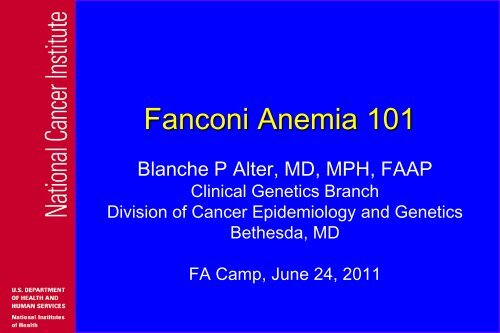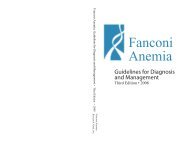Fanconi Anemia 101
Fanconi Anemia 101
Fanconi Anemia 101
Create successful ePaper yourself
Turn your PDF publications into a flip-book with our unique Google optimized e-Paper software.
<strong>Fanconi</strong> <strong>Anemia</strong> <strong>101</strong>Blanche P Alter, MD, MPH, FAAPClinical Genetics BranchDivision of Cancer Epidemiology and GeneticsBethesda, MDFA Camp, June 24, 2011
When You Hear …., Think …., Or ….
Koalas
Open Minds“I’ve never seen this before.”should be“I’ve never recognized this before.”
Question• How many think that the diagnosis of FAwas missed by one or more physiciansprior to being made?
History: Guido <strong>Fanconi</strong>• <strong>Fanconi</strong> <strong>Anemia</strong> (<strong>Fanconi</strong>pancytopenia syndrome): 1927, 3brothers with pancytopenia andphysical abnormalities,“perniziosiforme”• <strong>Fanconi</strong> Syndrome (renal<strong>Fanconi</strong> syndrome): 1936,proteinuria, glucosuria,phosphaturia, aminoaciduria,citraturia, and proximal renal tubularacidosis
<strong>Fanconi</strong> <strong>Anemia</strong>: ChildrenPhotos with permission
<strong>Fanconi</strong> <strong>Anemia</strong>: Adults
FA: Age at Diagnosis in LiteratureFrequency0 100 200 3006.5 yrFA0 10 20 30 40 50 60Age, Years
FA Literature: Physical Findings, 60%Low Birth WeightShortThumbsSkin hyperpigmentedGonads maleMicrocephalyRenalEyesSkin café au laitDevelopmental delayEars, deafRadiiCardiopulmonaryLegs, hips, feetGastrointestinal tractBrain/pituitaryGonads femaleShort or skin onlyM:F1.2:10 10 20 30 40 50 60PercentShimamura and Alter, Blood Reviews, 2010
Characteristics of Persons with FA• Physical findings described in the literaturemay not be found in all persons with FA• 11% had short stature and skin findings only• At least 25% of those reported had no physicalfindings• Some persons without physical findingsmay be diagnosed at a later age
FA: Laboratory Findings• Low blood counts (pancytopenia)• Large red cells (macrocytosis)• Increased fetal hemoglobin (Hb F)• Chromosome breakage in lymphocytes orfibroblasts cultured with a DNA crosslinker,e.g. diepoxybutane (DEB) or mitomycin C(MMC)
FA: HandsRightLeft
FA: Carrier Frequency• 1:300 in New York State in 1971 (Swift, 1971)• ~1:100 in Ashkenazi Jews, Afrikaners, SpanishGypsies, black sub-Saharan Africans• 1:181 in US in 2010• 1:93 in Israel in 2008 (Rosenberg et al, 2010)
FA: CBCs - Hand SurgeryHb and MCVWBC and Platelets1412014000350000121<strong>101</strong>2000300000<strong>101</strong>0010000250000Hb g/dl8690MCV, flWBC/ul80006000200000150000Plat/ul480400010000027020005000000 2 4 6 8Age, yrs6000 2 4 6 8Age, yrs0Hb, g/dlMCV, flWBC/ulPlat/ulAlter, J Hand Surg, 1992
FA: Surgery• Recommendations to surgeons andanesthesiologists:• Hb, platelets• MCV - increased early in marrowfailure• Trends may precede abnormal values
<strong>Fanconi</strong> <strong>Anemia</strong>: Definition• Autosomal recessive• 1 X-linked recessive gene• Physical findings• Aplastic anemia• Leukemia• Solid tumors• Chromosome instability• DNA repair defect• >15 genes ?
FA Inheritance• Persons with FA:• Unaffected parents carry one FA gene and onenormal gene (carriers)• Affected offspring get one FA gene from eachparent• Children of persons with FA:• Each child will have one FA gene (carriers)
Autosomal Recessive InheritanceAffected Carriers Normal
Autosomal Recessive InheritanceChild of affected and unaffected
Disease-Associated MutationsA mutation is a change in the normalbase pair sequenceCommonly used to define DNA sequencechanges that alter protein functionASCO modified 2/02
Thirteen <strong>Fanconi</strong> <strong>Anemia</strong> Subtypes15 FA Genes (?)O PData from Leiden Open Variation Database, http://chromium.liacs.nl/LOVD2/FANC/home.php
FA: Complementation Groups/GenesGroup Locus cDNA Exons AA %A 16q24.3 5.5 43 1455 ~70B Xp22.31 2.8 10 859 RareC 9q22.3 4.6 14 558 ~10D1/BRCA2* 13q12.3 11.4 27 3418 RareD2 3p25.3 5 44 1451 RareE 6p21-22 2.5 10 536 ~5F 11p15 1.3 1 374 RareG/XRCC9 9p13 2.5 14 622 ~10I/KIAA1794 15q25-26 4.5 38 1328 RareJ/BACH1/BRIP1* 17q22.3 4.6 20 1249 RareL/PHF9/POG 2p15-16.1 1.7 14 375 RareM/Hef 14q21.3 6.5 22 2014 RareN/PALB2* 16p12.1 3.5 13 1186 RareO/RAD51C* 17q25.1 2.7 9 76 RareP/SLX4* 16p13.3 26.6 15 1834 Rare*Breastcancergenes
FA/BRCA DNA Repair PathwayLBAC FED2IMGUBE2T<strong>Fanconi</strong><strong>Anemia</strong>CoreComplexubiquitinDNA damageOxidative stressCytokinesD2IJ/BRIP1BRCA1D1/BRCA2N/PALB2P/SXL4USP1D2IAdapted fromShimamura and Alter,Blood Reviews, 2010
Who Should be Tested for FA?• Characteristic birth defects (eg thumbs, kidneys,poor growth, etc)• Aplastic <strong>Anemia</strong> (AA)• Myelodysplastic Syndrome (MDS)• Acute Myeloid Leukemia (AML)• Decreased fertility• Early characteristic cancer• Siblings of persons with FA
What are the FA Tests?• Chromosome breakage, DEB or MMC• D2 ubiquitination (Western blot)• BRCA2 (Western blot)• Complementation with cell lines• Complementation with retroviruses• Sequencing of candidate genes (eg FANCCIVS4+4 A->T)• Sequencing of all cloned genesBlood lymphocytes, skin fibroblasts
Chromosomes
FA: D2 UbiquitinationShimamura et al, Blood, 2002Green and Kupfer,HemOnc Clin NA, 2009
Complementation Analysis, ClonedFANC Genes• FA cells are sensitive to DEB or MMC• Introduce specific cloned FA genes• Cells no longer sensitive• Normal gene ‘complemented’ patientcells, defining the complementation group• Cells still sensitive• Normal gene not identified for patient cells
Retrovirus-mediated Correction of FA CellsRetrovirus-mediated Correction of TA 0252's T-cells analyzed by flow cytometry after five days of MMC-Incubation100FANCAS11EG80SFAS11FCIEGcells alive [%]6040S11FEIEG2S11FFIEGS11FG2001 10 100 1000c (MMC) [nM]
Blood Production (Hematopoiesis)MyeloidStem CellPluripotentStem CellLymphoidStem CellTBRedCellsPlateletsLymphocytes
Bone Marrow BiopsyNormalAplastic
Proof of Mosaicism in FA• Peripheral blood lymphocytechromosome breakage test normal• Skin fibroblast chromosome breakagetest abnormal
Mosaicism from RecombinationAaAaAaaAaAaA
FA: Gastroenterology• Anatomical• Esophageal atresia, tracheoesophageal fistula, duodenalatresia, imperforate anus• GI Symptoms• Reflux, gastric emptying delay, poor appetite• Liver disease• Androgens: abnormal liver function, peliosis, adenomas,hepatomas,• Transfusions: iron overload• Nutrition• Enteral supplements via NG or NJ tubes or gastrostomies
FA: EndocrineFindingPer centAny 73Short and/or growth hormone deficient 51Abnormal lipids 55Hypothyroid 37Glucose/insulin 39Obese 27Metabolic syndrome 21Midline brain anomalies (50% small pituitary) 17Pubertal gonadal dysfunction (menses, fertility) 65Adult osteopenia/osteoporosis 92
FA: Complications• Aplastic <strong>Anemia</strong>• Acute Leukemia• Myelodysplastic Syndrome• Solid Tumors• Liver Tumors
Definitions• Aplastic <strong>Anemia</strong> (AA)• Pancytopenia• Hypocellular bone marrow• Acute Leukemia (AL)• Malignant proliferation of immature cells• Myelodysplastic Syndrome (MDS)• Cytopenias with hypercellular bone marrow
Aplastic <strong>Anemia</strong>: Signs and Symptoms• Thrombocytopenia• bruises, petechiae• <strong>Anemia</strong>• fatigue, lassitude, dyspnea• Neutropenia• infections
FA EventsAnnual RiskSTCumulative IncidenceBMFBMFAMLSTAML
“MDS” in FA• Clone alone does not have a bad prognosis.• Morphologic MDS + significant cytopeniasrequire treatment.Clone alone does not define MDS in FA.
FA: When to Treat Bone Marrow• Cytopenias• Hb
FA: Treatment for Bone Marrow• Transplant• Androgen +/- corticosteroid• Hematopoietic growth factors• Gene therapy?
FA: Treatment with Transplant• Bone marrow, cord blood, or peripheral bloodstem cells• HLA-related donor• when meet any treatment criteria• Alternate donor (mismatched unrelated[MUD], partial match family member)• Leukemia or clinical MDS (not clone alone)• Refractory aplastic anemia
FA: Medical Treatment• Oxymetholone• 2-5 mg/kg/day oral• Danazol• ~200-400 mg/day oral• Folic acid• 1 mg/day oral
FA: Treatment with G-CSF• 5 µg/kg/day subcutaneous• Decrease dose and/or give onalternate days• Keep absolute neutrophil count>1000/mm 3
FA: Supportive Care• RBCs - for Hb
FA: Surveillance• CBC every 4 months or more often• BM annually• aspirate for morphology• biopsy for cellularity• cytogenetics• special stains• flow cytometry• Liver enzymes, ultrasound annually
FA Literature: Cancer Types 1927-20099%3% 2%86%AML 150AL 15ALL 6CMML 41% 1% 0%3% 2% 2% 0%3%4%7%9%11%12%23%22%Liver 46HNSCC 43Brain 24Vulva 21Renal/Wilms 17Esophagus 14Breast 7Cervix 6Neuroblastoma 6Lung 4Stomach 3Lymphoma 2Sarcoma 2Bladder 1Retinoblastoma 1175 leukemias and 197 solid tumors in 320/2000 patients;26 had 2-4 cancers.
FA Adverse EventsAnnual RiskSTCumulative IncidenceBMFBMFAMLSTAML
Relative Risk of Cancer in FAParameter Obs* Exp* OverallNumber of Patients 459 459Person-Years 6839 6839All Cancers 85 1.8 ~50xAll Solid Tumors 46 1.3 ~40xOral Cavity/Pharynx 14 0.02 ~700xVulvar 10 0 ~3000xAML 6 0.06 ~500xMDS 55 0 ~7000x*Observed; Expected
FA: Adult Males• Short stature• Infertility• Endocrine problems: cholesterol, thyroid,growth hormone, metabolic syndrome,small pituitary, osteopenia• Cancer• AML• HNSCC• HPV vaccine?
FA: Adult Females• Late onset of menses (14-16)• Heavy periods if platelets low• Early onset of menopause (30s)• Decreased fertility• Increased need for Caesarean sections• Worsening of bone marrow function during pregnancy• Osteoporosis• Cancer• AML• HNSCC• Vulva, vagina, cervix• Human papilloma virus• HPV Vaccine
FA Surveillance: Cancer• Oral cavity and pharynx• Age >10 years• BMT >1 year• Gynecologic• Age >16 years• Menarche• Liver• Liver enzymes every 3-4 months• Liver ultrasound every 6-12 months• Skin• Annual exam
Field Trip
FA Adult Care: Recommendations• CBC every 4-6 months• BM aspirate/biopsy/chromosomes every year• Dental every year• Head and neck with laryngoscopy every year• Gyn exam with Pap and HPV every year• HPV vaccine• Consider esophageal endoscopy?
FA Survival 1927 to1999; 2000-2009Probability0.00 0.25 0.50 0.75 1.00FA21 29p
www.marrowfailure.cancer.gov
















